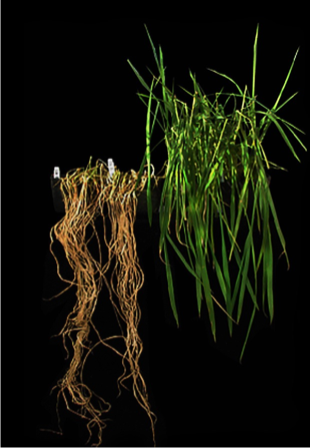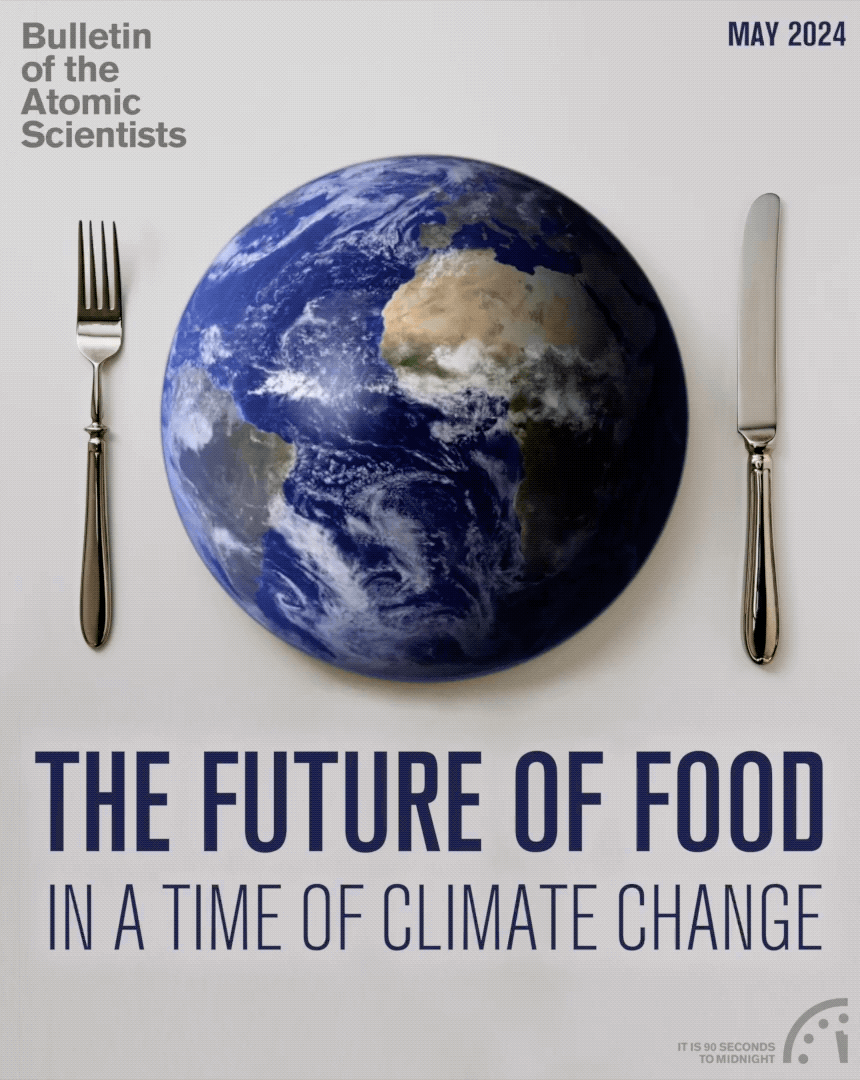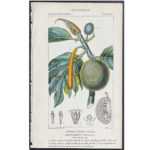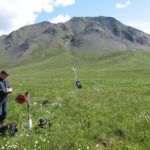We need to act now to ensure global food security and reduce agricultural greenhouse gas emissions
By Bradley R. Ringeisen, Clarice de Azevedo Souza, Elizabeth Njuguna, Pamela C. Ronald | May 7, 2024
We need to act now to ensure global food security and reduce agricultural greenhouse gas emissions
By Bradley R. Ringeisen, Clarice de Azevedo Souza, Elizabeth Njuguna, Pamela C. Ronald | May 7, 2024
Nearly one-third of global anthropogenic greenhouse gas (GHG) emissions stem from the global food system. Approximately 70 percent of these emissions are associated with agriculture and land-use change activities (FAO 2022). Even if we were to stop all other sources of emissions, global food consumption alone could account for nearly a one-degree Celsius rise in temperature (1.7 degrees Fahrenheit) by the end of this century (Ivanovich et al. 2023).
Global food security is also directly threatened by climate change itself, creating an unfortunate positive feedback loop. The world is already seeing dramatic oscillations in weather patterns with more droughts, floods, and diseases that can spread faster and further and threaten entire global crops like corn, bananas, rice, and wheat. Often these effects are most dramatically felt by farmers in low-income countries (Acevedo et al. 2017) that cannot afford high-yield hybrids or do not have access to climate-resilient varieties (Takahashi, Muraoka, and Otsuka 2020).
Both of these problems—agricultural emissions and crop loss due to climate disasters—will worsen as the climate changes and the global population rises (estimated to rise by nearly 2 billion more people over the next 26 years). The world needs to answer a very real question in the coming two decades: How are we going to feed nearly 10 billion people without further destroying our planet?
Appropriately enough for what has been described as the “Century of Biology,” a solution may lie in the most recently developed genomic technologies, which promise to increase crop yields and to make the staple foods that we humans rely on more resistant to extremes of weather and better able to fight off the new diseases that will be introduced as the planet changes temperature and formerly temperate zones become warmer—expanding the reach of what were formerly exclusively tropical pests and diseases. To do so, we can turn to manipulating the genetic sequence of crops with exquisite genome editing tools, such as clustered regularly interspaced short palindromic repeats (CRISPR), to literally cut (turn off) and paste (add in or turn on) genes at precise locations in human, plant, and microbial cells. And, not coincidentally, the ability to do these things means that we are accelerating our pace of understanding of not just individual organisms but entire communities of organisms, mapping their collective metabolisms, communications, and interdependencies.
This understanding is important, because there is an intricate, largely unseen dance going on between plants and microorganisms in the soil, that enables farmers to grow crops. (Yet another interaction is played out between livestock and the microbes that enable animals to digest feed and convert it into biomass. Unfortunately, these microbes often produce difficult-to-mitigate and tremendously potent GHG emissions such as methane and nitrous oxide.) But there is hope. If these interdependencies can be understood, then there is a world of molecular biology tools that can be unleashed to reduce and even turn off these emissions.
Land plants have populated Earth for around 700 million years, showing an immense diversity and adaptability. However, the plants that humans grow for food are highly selected and often grown in what is called a “monoculture”—the practice of using a single variety across large geographic areas. These crops are under attack by a number of emerging threats, including higher peak temperatures, more frequent and severe floods, higher winds, pests and disease. For example, citrus crops are threatened by bacterial pathogens, bananas by fungal pathogens, and cereals—like rice and wheat—by fungi, bacteria, and viruses. One report states that up to five percent of the world’s food supply has been lost to climate disasters over the last 30 years, enough food for half-a-billion people a year (Michel 2023). CRISPR and other biotechnologies can be used to dramatically accelerate the development of crops that can withstand environmental stress, pests, and disease, requiring fewer farmer inputs like irrigation and pesticides, and create crops that can withstand more frequent climate disasters.
What is the realm of the present, probable and possible worlds where biotechnology is used to help feed Earth’s growing population in a sustainable and climate resilient way? (See Figure 1 at top of page.)
The present
Agriculture has been benefiting from biotechnology for decades. To name just two examples, there are varieties of climate-resilient rice that were developed years ago through what are known as marker-assisted technologies; and there are pest and disease-tolerant crops developed through biotechnology. Genome editing technology is just over 10 years old, and it is already carving out its place on the breeding pipelines. The current state of the art in gene editing is through the loss of gene function (gene knock-out) or the disruption of normal gene expression, because it is relatively simple and less technically challenging than inserting fully functional genes.
CRISPR-edited crops are now approved in several countries for a broad set of applications ranging from climate resiliency to improvements in post-harvest shelf-life and nutritional quality. In the time since the white button mushroom (Agaricus bisporus) made headlines for being the first CRISPR-edited crop to receive authorization from the US Department of Agriculture for commercialization, several edited crops are following—including a semi-dwarf banana developed to withstand the challenges caused by typhoons and storms; rice with enhanced tolerance to salinity; tomatoes with broad-spectrum disease resistance; grapes that are resistant to fungal disease; less-toxic cassava; and several non-browning forms of produce such as potato, eggplant, banana, and avocado (Biotech Updates 2023).
The next generation of CRISPR-edited crops is in development and field trials are taking place in Asia and Africa, as well as South and North America. The regulatory environment for genome-edited crops is trying to keep pace, actively evolving with a focus on how similar an edited product is to a conventionally bred product. Notably, more countries besides those in the Americas are currently reviewing and updating their policies and guidelines in response to the rapid advances in biotechnology—including places in Asia, Africa, and Europe that were previously reluctant to use these modern breeding techniques (Dionglay 2024).
The probable
CRISPR technology continues to progress at lightning speed. CRISPR-edited crops with improved yields and enhanced nutrition, and resilience to drought and disease may soon become available. It is likely that precise gene insertions (or what are known as “knock-ins”), including multiple genes at once, will become routine and have tremendous impact in crop improvement—for example, by conferring broad and long-lasting immunity to diseases, which will greatly reduce pesticide use and prevent billions of dollars in crop losses.
Techniques for more subtle and precise editing will enable fine-tuning of desirable crop characteristics, such as variation in fruit size and drought tolerance thresholds, or confer beneficial environmental adaptations without altering the original genetic sequence. These editing technologies may be useful tools to adapt crops to specific soil types, climate conditions, and market preferences.
Additional groundbreaking innovations, such as bypassing the need for costly tissue culture, the rapid generation of stably edited plant varieties, and technology to propagate high yielding hybrid crops through seed harvesting (rather than the current practice of farmers purchasing seeds from suppliers every year, which is prohibitively costly for farmers in many regions in the world), promise to make edited crops more desirable to growers, cheaper to consumers, and more accessible to developers in locations with less resources or specialized infrastructure.
The possible
Genomic technologies can be used to guide the development of agricultural systems (e.g. rice, cows) with reduced methane emissions and crops that require less nitrogen fertilizer (and therefore less nitrous oxide emissions) or pesticides. These tools can also be used to develop crop systems that can more effectively build soil organic carbon and to reduce a significant fraction of other anthropogenic GHG emissions.
Creative approaches using CRISPR will be used to drive ecological outcomes, for example, by editing plants to influence the microbial population associated with its roots in the soil. Approaches to stimulate beneficial plant-microbe associations may improve soil health (with the potential to eliminate current deforestation practices), allow plants to produce more food while requiring less fertilizer inputs, reducing both run-off pollution and GHG emissions (Yan et al. 2022), and may prove to be a scalable biological solution to remove excess carbon from the atmosphere.
The (potential) problems
Regulatory hurdles still need to be resolved. Regulators are often not technical experts and are slow to adapt to new genome editing and other biotechnologies, affecting the pace of global innovation and reducing the market size for such technologies. A worldwide misalignment of regulatory requirements may also pose a challenge for commercialization and distribution, since the developers have to meet the unique requirements of each target country.
While most consumers have embraced medical biotechnologies, misinformation has made some consumers skeptical about agricultural biotechnologies (National Academies of Sciences, Engineering, and Medicine 2019), which may hinder or slow the adoption of editing technologies in agriculture. A delay in adoption can cause billions of dollars in losses for economies worldwide and may represent a lost opportunity to lift the most vulnerable communities out of hunger and poverty (Van Eenennaam et al. 2021; Zilberman et al. 2021) .
Intellectual property constraints may also limit the global democratization of genomic agricultural innovations, limiting access to technology and products through reduced accessibility and unaffordable costs.
The opportunities
We have been domesticating animals and growing plants and intentionally improving them genetically for our benefit for thousands of years. It is this inherent drive and capacity to build upon nature that enabled human populations to expand and thrive. The advent of CRISPR-enabled genome editing and other biotechnologies gives us unprecedented control, and the way in which we implement these powerful technologies will have an enormous impact in every aspect of our future. Given the growing trajectory of the global population and the increasing effects of climate change, it is now imperative that we embrace every tool possible to reach a more sustainable existence. These tools should include the use of a range of biotechnologies, which offer unique opportunities to address agricultural challenges by precisely and expeditiously improving crops to produce more food on less land, to draw down more carbon from the atmosphere into soils, and to reduce GHG emissions from agricultural systems. (See Figure 2 below.)

The precise and targeted crop genetic improvement offered by CRISPR editing has altered the conversation around genetic engineering and its regulation. As policy makers and regulators come to understand that the products of CRISPR editing are no different than crops that could otherwise be obtained through conventional breeding, we can expect an exponential wave of plants edited for a broad range of traits to surface in the coming years. Worldwide, CRISPR applications in climate and agriculture are already starting to bloom. There are more than 500 products in different stages of product development, ranging from basic research to advanced R&D and near-commercialization (Bullion and Malhotra 2023.).
With biotechnologies reducing the technical barriers for genetic manipulation, our limitations will lie on the precise mechanistic understanding of the fundamental biological, ecological, and biogeochemical processes that rule the web of life. Advanced sequencing technologies available today can give you a complete picture of every organism present in a tiny sample of soil, including who is there and what their genome is—and suggest what roles these genes play within the organism and in the ecosystem. However, to date, we know the function of only a small percentage of genes in crops and microbes. This fundamental knowledge is essential if we want to dramatically accelerate the pace of scientific discovery, disentangle the intricate relationships within and between species, and uncover the full complexity of life from molecules to the biosphere.
A second bottleneck for realizing the promise of the Century of Biology will be our ability to transform these scientific breakthroughs into real-world solutions, which will require vision, inclusive partnerships, committed funding, political will, and ultimately acceptance by society.
Scaling to global impact
The adoption of genetically engineered crops around the world in the past decades has been close to 100 percent in some countries, with farmers seeing dramatic reductions in the use of insecticide sprays and increases in yield. However in other countries, adoption has been slow or nonexistent due to fears about biotechnology (“Biotech Crops Drive Socio-Economic Development and Sustainable Environment in the New Frontier,” n.d.). Although every major scientific organization has concluded that the genetically engineered crops currently on the market are safe to eat and safe for the environment, these concerns persist in some communities.
In contrast, CRISPR technology specifically has been positively received across the globe because many of the edits made are indistinguishable from naturally occurring mutations or ones that can be made using conventional breeding techniques. Several countries have decided to exempt some types of edited crops from their existing regulations about genetic engineering (“Breaking Barriers with Breeding: A Primer on New Breeding Innovations for Food Security – ISAAA Brief 56-2021” n.d.; Buchholzer and Frommer 2023). The wider acceptance and public trust in CRISPR technology and products has been exemplified by India, a country with a human population of more than 1.4 billion, whose government recently provided significant funding to several agricultural institutions in the country to advance genome editing research.
Fewer regulations dramatically lowers the cost and time of development, which has attracted a diverse group of developers and broadened the scope of target crops (Whelan, Gutti, and Lema 2020). Research institutes and small- to medium- sized enterprises are the main leaders in the development and commercialization of genome-edited products, that aim to benefit consumers, human health, animal welfare, and the environment (Whelan, Gutti, and Lema 2020). A fast pace of development of new crop varieties will be a key determinant for climate resilience. Currently, the average age of a maize variety in sub-Saharan Africa and rice variety in South Asia is between 14-25 years (Singh et al. 2020), which is not on par with demand.
A persistent challenge is how to get the improved seeds to farmers. Many large non-profit organizations have spent much time and effort on seed dissemination with limited or mixed results. Organizations such as CGIAR—a global agricultural research and translational center— and National Agricultural Research Systems are two important players in the seed distribution system; however, it is clear that there is a need to build up complementary local extension systems and economies and focus on crops where farmers can save seeds. A welcome breakthrough was the development of synthetic apomictic hybrid rice, developed at UC Davis in collaboration with CIRAD, France, which can be propagated through seeds (Khanday et al. 2019; Vernet et al. 2022). (Reproduction through apomixis bypasses the genetic recombination which happens during sexual reproduction, so the resulting seeds are genetically identical to the mother plant and will thus provide identical traits.) Expansion of apomictic hybrid technology will go a long way in providing high-yielding, climate-resilient seed varieties that farmers can save and replant. Hybrids are bred for their increased yields and overall superior performance; however, despite its superior quality over inbred lines, the cost of hybrids is prohibitive in many regions in the world. Accessible, self-propagating hybrids may play an important role in safeguarding food-security in vulnerable regions of the world while providing economic gains for farmers and their families.
Scaling up genome-edited crops and other products globally and especially where they can make a significant impact will require a collaborative multifaceted approach involving policy and regulation, science, education, and infrastructure. Well thought-out licensing/ technology transfer agreements and market incentives such as subsidies and tax-breaks for lower-income countries will ensure affordable and equitable access to genome-editing tools, resources, and products. Precedence has been set for international coordination on regulation of biotechnology, such as the Cartagena Protocol—but similar frameworks are important to facilitate agreeable movement of genome-edited products, especially for regions of highest need.
Now is the time to act
Even with the biology revolution accelerating the development of new crops that can withstand a rapidly changing climate, the agricultural and climate biotechnology community needs significant increases in funding from governments and private enterprise.
More R&D funding from governments and philanthropists will accelerate the fundamental discoveries needed to realize the technologies described above. In order for discoveries to be scaled from the lab to fields around the world, both non-profit partnerships and venture-backed startups are needed, but both these scaling paths require early-stage, equity-free funding to get proof-of-concept data.
Development of these technologies is a win-win for society, providing needed food security while reducing GHG emissions and reducing the need for critical resources like water, phosphorous, and nitrogen. Simultaneously, farmers could grow many improved varieties on marginal lands, improving soil fertility year-over-year and reducing the need for continued deforestation.
Improved agricultural systems through application of genome editing and other biotechnologies can provide these benefits to farmers and communities without relying solely on a carbon market to drive innovation and scale. The future is now: Ideas and new technologies abound. With appropriate partnerships, funding, and regulatory guidance, the global biotech innovation community is ready to accept the challenge to leap into a sustainable future.
Funding
The Climate and Sustainable Agriculture Program at the Innovative Genomics Institute at UC-Berkeley is funded by philanthropic donations from the Chan Zuckerberg Initiative and other anonymous donors. We also receive funding through grants and industry partnerships. Pamela C. Ronald also thanks the Rockefeller Bellagio residency program.
Together, we make the world safer.
The Bulletin elevates expert voices above the noise. But as an independent nonprofit organization, our operations depend on the support of readers like you. Help us continue to deliver quality journalism that holds leaders accountable. Your support of our work at any level is important. In return, we promise our coverage will be understandable, influential, vigilant, solution-oriented, and fair-minded. Together we can make a difference.
Keywords: Crispr, agriculture, food security, genomic editing, genomic technology
Topics: Climate Change, Special Topics
























